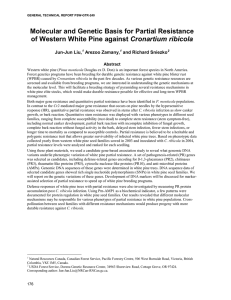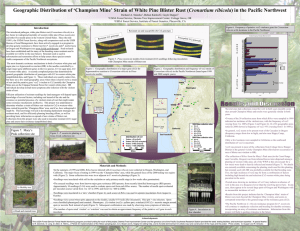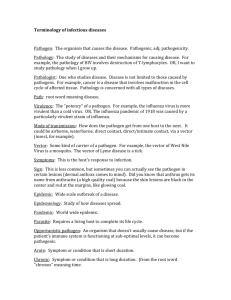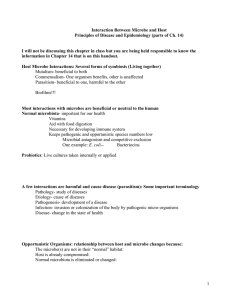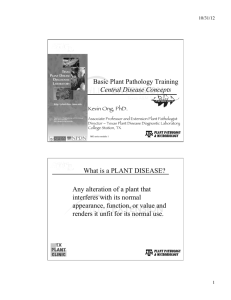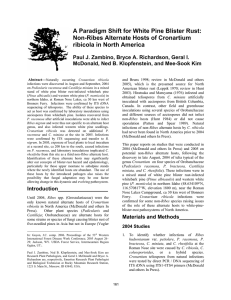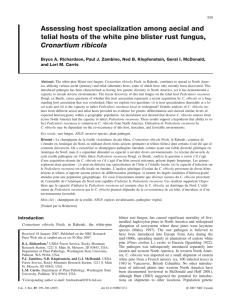Are Needle Reactions in Resistance to Cronartium ribicola Katarina Sweeney,
advertisement
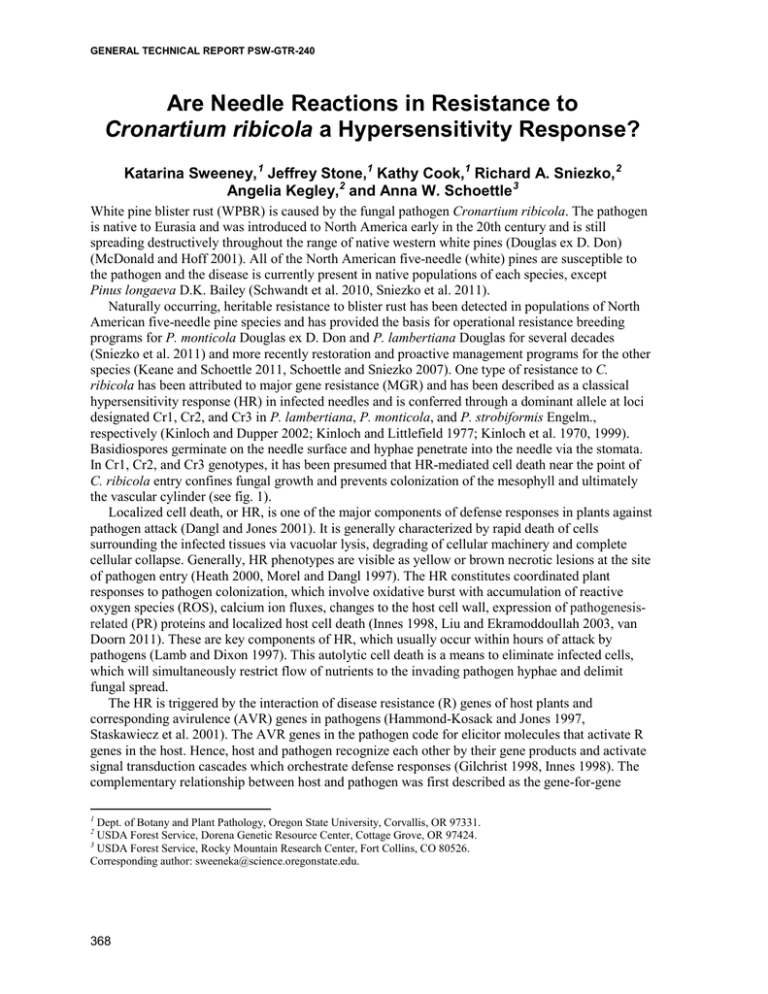
GENERAL TECHNICAL REPORT PSW-GTR-240 Are Needle Reactions in Resistance to Cronartium ribicola a Hypersensitivity Response? Katarina Sweeney, 1 Jeffrey Stone,1 Kathy Cook,1 Richard A. Sniezko, 2 Angelia Kegley,2 and Anna W. Schoettle 3 White pine blister rust (WPBR) is caused by the fungal pathogen Cronartium ribicola. The pathogen is native to Eurasia and was introduced to North America early in the 20th century and is still spreading destructively throughout the range of native western white pines (Douglas ex D. Don) (McDonald and Hoff 2001). All of the North American five-needle (white) pines are susceptible to the pathogen and the disease is currently present in native populations of each species, except Pinus longaeva D.K. Bailey (Schwandt et al. 2010, Sniezko et al. 2011). Naturally occurring, heritable resistance to blister rust has been detected in populations of North American five-needle pine species and has provided the basis for operational resistance breeding programs for P. monticola Douglas ex D. Don and P. lambertiana Douglas for several decades (Sniezko et al. 2011) and more recently restoration and proactive management programs for the other species (Keane and Schoettle 2011, Schoettle and Sniezko 2007). One type of resistance to C. ribicola has been attributed to major gene resistance (MGR) and has been described as a classical hypersensitivity response (HR) in infected needles and is conferred through a dominant allele at loci designated Cr1, Cr2, and Cr3 in P. lambertiana, P. monticola, and P. strobiformis Engelm., respectively (Kinloch and Dupper 2002; Kinloch and Littlefield 1977; Kinloch et al. 1970, 1999). Basidiospores germinate on the needle surface and hyphae penetrate into the needle via the stomata. In Cr1, Cr2, and Cr3 genotypes, it has been presumed that HR-mediated cell death near the point of C. ribicola entry confines fungal growth and prevents colonization of the mesophyll and ultimately the vascular cylinder (see fig. 1). Localized cell death, or HR, is one of the major components of defense responses in plants against pathogen attack (Dangl and Jones 2001). It is generally characterized by rapid death of cells surrounding the infected tissues via vacuolar lysis, degrading of cellular machinery and complete cellular collapse. Generally, HR phenotypes are visible as yellow or brown necrotic lesions at the site of pathogen entry (Heath 2000, Morel and Dangl 1997). The HR constitutes coordinated plant responses to pathogen colonization, which involve oxidative burst with accumulation of reactive oxygen species (ROS), calcium ion fluxes, changes to the host cell wall, expression of pathogenesisrelated (PR) proteins and localized host cell death (Innes 1998, Liu and Ekramoddoullah 2003, van Doorn 2011). These are key components of HR, which usually occur within hours of attack by pathogens (Lamb and Dixon 1997). This autolytic cell death is a means to eliminate infected cells, which will simultaneously restrict flow of nutrients to the invading pathogen hyphae and delimit fungal spread. The HR is triggered by the interaction of disease resistance (R) genes of host plants and corresponding avirulence (AVR) genes in pathogens (Hammond-Kosack and Jones 1997, Staskawiecz et al. 2001). The AVR genes in the pathogen code for elicitor molecules that activate R genes in the host. Hence, host and pathogen recognize each other by their gene products and activate signal transduction cascades which orchestrate defense responses (Gilchrist 1998, Innes 1998). The complementary relationship between host and pathogen was first described as the gene-for-gene 1 Dept. of Botany and Plant Pathology, Oregon State University, Corvallis, OR 97331. USDA Forest Service, Dorena Genetic Resource Center, Cottage Grove, OR 97424. 3 USDA Forest Service, Rocky Mountain Research Center, Fort Collins, CO 80526. Corresponding author: sweeneka@science.oregonstate.edu. 2 368 Proceedings of the 4th International Workshop on Genetics of Host-Parasite Interactions in Forestry hypothesis by Flor (1942, 1955). This system is highly specific, as only pathogens with AVR genes are detected by the host and subsequently induce the HR response in host tissues. Accordingly, genotypes of C. ribicola virulent to Cr1 P. lambertiana and Cr2 P. monticola have been termed vcr1 and vcr2, respectively (Kinloch and Dupper 2002). Complementary virulence, avirulence, and resistance genes in C. ribicola and white pine host species appears to conform to the Flor gene-forgene model (Kinloch and Dupper 2002). In the C. ribicola pathosystem, the HR paradigm was described for the Cr1 phenotype in P. lambertiana and the Cr2 phenotype in P. monticola. Individuals resistant to C. ribicola were reported as having cell degeneration and necrosis leading to localized cell death at the site of fungal infection sufficient to stop pathogen growth. Kinloch and Littlefield (1977) noted that the onset of HR in resistant pines differs from that in classical HR; the onset of needle lesions in P. lambertiana is not observed until several weeks or even months after initial entry of C. ribicola. This observation suggests that the resistance mechanisms expressed by Cr1 or Cr2 may differ from the pattern of HR responses seen in most incompatible host reactions. To further evaluate the apparent HR response in this pathosystem, we undertook structural analyses of early C. ribicola colonization in susceptible and resistant P. monticola and P. lambertiana. Resistant and susceptible P. albicaulis Engelm. and P. flexilis James phenotypes are also being compared to the reactions seen in susceptible and Cr1 and Cr2 seedlings. Secondary needles were harvested from 2-year-old seedlings grown and inoculated at the U.S. Department of Agriculture, Forest Service, Dorena Genetic Resource Center (DGRC) in Cottage Grove, Oregon. The histopathology of infection in resistant P. monticola and P. lambertiana suggests that the symptoms associated with HR phenotypes and their underlying physiology are fundamentally different from the typical HR described in other host- pathogen systems (fig. 2). We observed extensive proliferation of fungal hyphae in the host and penetration of the needle endodermis and vascular tissue by the pathogen prior to the onset of cell necrosis. Furthermore, preliminary results suggest the amount of fungal tissue present and its growth may be similar for both resistant and susceptible white pines (fig. 2). Our results suggest that although resistance to WPBR in P. monticola and P. lambertiana conforms to the genetic model of HR, the mechanism of resistance may differ from that of typical HR. Histological examination of infected needles from Cr1 and Cr2 seedlings suggest that the blister rust pathogen proliferates within the host rapidly after inoculation and several weeks before the onset of typical macroscopic needle lesion symptoms or microscopic signs of autolytic cell death or tissue necrosis. Analyses of infection in resistant and susceptible P. albicaulis and P. flexilis phenotypes will provide additional insights. Resulting information will be used to help interpret resistance mechanisms in the species and provide baseline information useful for resistance breeding and disease management. 369 GENERAL TECHNICAL REPORT PSW-GTR-240 Figure 1—Cross section from a non-inoculated Pinus monticola secondary needle embedded with methacrylate and stained with toluidine blue. Arrows indicate the infection pathway. Pathogen enters through the stoma and grows within the mesophyll. The endodermis forms a barrier between mesophyll and vascular tissue. Crossing the endodermal layer and entrance into the vascular tissues allows the pathogen to spread into stem. Scale bar = 100µm. (Image: K. Cook) Figure 2—Cross section from resistant (Cr1) Pinus lambertiana secondary needle embedded with methacrylate and stained with toluidine blue. Sample taken from 2-year-old seedling, 6 weeks after inoculation with wild-type rust. Arrows point to Cronartium ribicola invading vascular tissues and endodermal cells. Scale bar = 100um. (Image: K. Cook) Literature Cited Dangl, J.L.; Jones, J.D. 2001. Plant pathogens and integrated defence responses to infection. Nature. 411: 826–833. Flor, H.H. 1942. Inheritance of pathogenicity in Melampsora lini. Phytopathology. 32: 653–669. Flor, H.H. 1955. Host-parasite interaction in flax rust - its genetics and other implications. Phytopathology. 45: 680–685. Gilchrist, D.G. 1998. Programmed cell death in plant disease: the purpose and promise of cellular suicide. Annual Review of Phytopathology. 36: 393–414. Hammond-Kosack, K.E.; Jones, J.D.G. 1997. Plant disease resistance genes. Annual Review of Plant Physiology and Plant Molecular Biology. 48: 575–607. Heath, M.C. 2000. Hypersensitive response-related death. Plant Molecular Biology. 44: 321–334. 370 Proceedings of the 4th International Workshop on Genetics of Host-Parasite Interactions in Forestry Innes, R.W. 1998. Genetic dissection of R gene signal transduction pathways. Current Opinion in Plant Biology. 1: 299–304. Keane, R.E.; Schoettle, A.W. 2011. Strategies, tools, and challenges for sustaining and restoring high elevation five-needle white pine forests in western North America. In: Keane, R.E.; Tomback, D.F.; Murray, M.P.; Smith, C.M., eds. The future of high-elevation, five-needle white pines in western North America: proceedings of the high five symposium. Proc. RMRS-P-63. Ft. Collins, CO: U.S. Department of Agriculture, Forest Service, Rocky Mountain Research Station: 276–294. Kinloch, B.B. Jr.; Littlefield, J.L. 1977. White pine blister rust: hypersensitive resistance in sugar pine. Canadian Journal of Botany. 55:1148–1155. Kinloch, B.B. Jr.; Parks, G.K.; Fowler, C.W. 1970. White pine blister rust: simple inherited resistance in sugar pine. Science. 167:193–195. Kinloch, B.B. Jr.; Sniezko, R.A.; Barnes, G.D.; Greathouse, T.E. 1999. A major gene for resistance to white pine blister rust in western white pine from the western Cascade Range. Phytopathology. 89: 861–867. Kinloch, B.B. Jr.; Dupper, G.E. 2002. Genetic specificity in the white pine/blister rust pathosystem. Phytopathology. 92: 278–280. Lamb, C.; Dixon, R.A. 1997. The oxidative burst in plant disease resistance. Annual Review of Plant Physiology and Plant Molecular Biology. 48: 251–275. Liu, J.J.; Ekramoddoullah, A.K.M. 2003. Isolation, genetic variation and expression of TIR-NBS-LRR resistance gene analogs from western white pine (Pinus monticola Dougl. Ex. D. Don.). Molecular Genetics and Genomics. 270: 432–441. McDonald, G.I.; Hoff, R.J. 2001. Blister rust: an introduced plague. In: Tomback, D.F.; Arno, S.F.; Keane, R.E., eds. Whitebark pine communities: ecology and restoration. Washington, DC: Island Press: 193–220. Morel, J.B.; Dangl, J.L. 1997. The hypersensitive response and the induction of cell death in plants. Cell Death and Differentiation. 4: 671–683. Schoettle, A.W.; Sniezko, R.A. 2007. Preparing the landscape for invasion – proactive intervention to mitigate impacts of a non-native pathogen. Journal of Forest Research. 12: 327–336. Schwandt, J.W.; Lochman, I.B.; Kliejunas, J.T.; Muir, J.A. 2010. Current health issues and management strategies for white pines in the western United States and Canada. Forest Pathology. 40: 226–250. Sniezko, R.A.; Mahalovich, M.F.; Schoettle, A.W.; Vogler, D.R. 2011. Plenary paper: past and current investigations of the genetic resistance to Cronartium ribicola .in Keane, R.E.; Tomback, D.F.; Murray, M.P.; Smith, C.M., eds. The future of high-elevation, five-needle white pines in western North America: proceedings of the high five symposium. Proc. RMRS-P-63. Ft. Collins, CO: U.S. Department of Agriculture, Forest Service, Rocky Mountain Research Station: 246–264. Staskawicz, B.J.; Mudgett, M.B.; Dangl, J.L.; Galan, J.E. 2001. Common and contrasting themes of plant and animal diseases. Science. 292: 2285–2289. van Doorn, W.G. 2011. Classes of programmed cell death in plants, compared to those in animals. The Journal of Experimental Botany. 62: 4749–4761. 371

